Lindrick 57: The story of GB&I’s last Ryder Cup victory
Dai Rees led his team to a memorable win over the USA at Lindrick in South Yorkshire
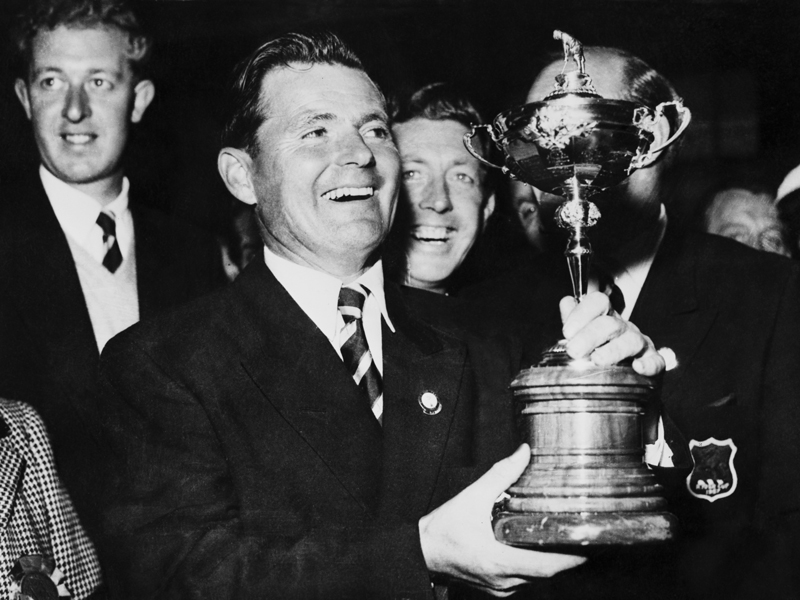

59 years after GB&I’s last win over the USA in the Ryder Cup, Fergus Bisset looks back at an outstanding performance by Dai Rees and his team at Lindrick in 1957.
In 1937 a 24-year-old Welshman called Dai Rees made his Ryder Cup debut at Southport and Ainsdale in Lancashire. The young rookie put on an impressive display, earning the praise of Gene Sarazen after halving with him in the foursomes, then going on to defeat Byron Nelson in a superb singles effort. Unfortunately it wasn’t enough for GB&I to regain the Cup. The Americans took the match by 8-4 to win for the first time on British soil. Rees would go on to play in eight more Ryder Cups and would be instrumental when Britain and Ireland secured their final victory in the event, 20 years after his first appearance.
After a 10-year hiatus because of the Second World War, Rees was part of the GB&I team that suffered an 11-1 thrashing in Oregon in 1947. He played again in 1949, 51 and 53 before travelling to California in 1955 as playing captain. Although the match at Thunderbird Country Club resulted in another defeat for the British and Irish, there were glimmers of hope for the beaten side. Rees proved himself a dynamic and tenacious captain, his side had accrued more points than any before on U.S. soil and the majority of the 12 matches had been closely contested.
However, there were mutterings of discontent. Today the Ryder Cup is watched by hundreds of millions and, as such, is a profitable event. In the 1950s, (in fact right up to the mid 1980s,) the Cup was run at a loss. With the U.S. so dominant in terms of results, there were suggestions the contest was becoming an expensive damp squib and should be postponed until GB&I could field a side capable of giving the yanks a run for their money.
The 1957 Ryder Cup was in danger of not taking place at all until noted Sheffield industrialist Sir Stuart Goodwin stepped in with a personal donation of £10,000 to the PGA. One of the criteria for his beneficence was he was to have a say in the venue for the event. The choice was Lindrick, just outside Worksop to the west of Sheffield. Largely the selection was because of the proximity to Goodwin’s hometown, but it was also decided upon for strategic reasons. Most of the home side, and Dai Rees in particular, knew the Yorkshire track well, but, as it hadn’t been used before for major championships, the Americans would have no clue about it. Also, it would be possible to set the track up in the hosts’ favour. The plan was to get the fairways and greens firm and fast-running and to grow the rough through the putting surfaces. The Americans, used to softer targets, would find themselves bounding through the greens into tangled lies. The British would be wise to the threat and play to the conditions.
The Americans were blissfully unaware of the scheming on the other side of the Atlantic. Even if they’d known, they wouldn’t have been worried. They’d won the last seven Ryder Cups and, since the war, American players had won 35 of the 48 Majors contested, compared to just three by golfers from Britain and Ireland. So confident were they of retaining the Cup that the USPGA renewed the insurance coverage on the trophy before the team had even left for Britain.
The U.S. side that crossed the Atlantic early in the autumn of 1957 was, however, missing a few star names. Sam Snead and Ben Hogan were not selected because they hadn’t participated in enough counting USPGA events over a two-year period; Jimmy Demaret, Cary Middlecoff and Julius Boros were omitted because they hadn’t teed it up in the USPGA Championship. Later in October, Demaret was outspoken in his criticism of the American selection process. “I could have picked a better team blindfolded,” he said.
Get the Golf Monthly Newsletter
Subscribe to the Golf Monthly newsletter to stay up to date with all the latest tour news, equipment news, reviews, head-to-heads and buyer’s guides from our team of experienced experts.
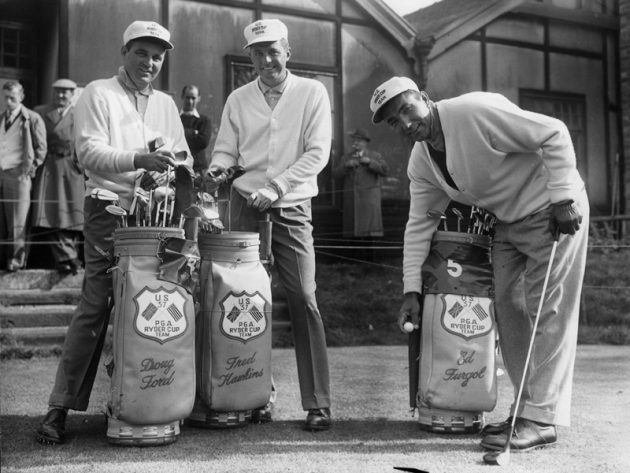
Still, the squad that travelled was not without experience. Doug Ford, Dick Mayer and Lionel Hebert were respective winners of the 1957 Masters, U.S. Open and USPGA Championship and five of the seven others had been, or would be, Major champions.
“But reputation is no guarantee of success,” said Bernard Darwin of the visiting side in The Times.
The British and Irish team contained just one Major champion – Max Faulkner who had won The Open of 1951. But the press at the time, and the players themselves, felt this was one of the strongest British and Irish teams to have been assembled for the biennial match. From the Ryder Cup’s inception in 1927 until 1959, its format was four 36-hole foursomes matches on day one, then eight 36-hole singles contests on day two. With two thirds of the points available in the singles, the match could be neither won nor lost on day one. Having said that, in nine of the 11 previous matches the team leading after the foursomes had gone on to win overall. So getting off to a solid start was of significant importance.
U.S. captain Jack Burke Junior sent out what he believed to be his strongest pairing first – Masters champion Doug Ford and the on-form Dow Finsterwald.
Dai Rees also selected a formidable opening pairing in the shape of Peter Alliss and Bernard Hunt. The Englishmen had made their debuts in the 1953 Ryder Cup aged 22 and 23, but memories from that event were not good. Alliss had been one up with three to play in his singles match against Jim Turnesa, but he’d bogeyed the 16th, hit out-of-bounds on the 17th then missed a three-foot putt on the last for a half. Hunt had been one ahead of Dave Douglas on the 18th but then stumbled to a double bogey and halved the match. GB&I had lost overall by a single point.
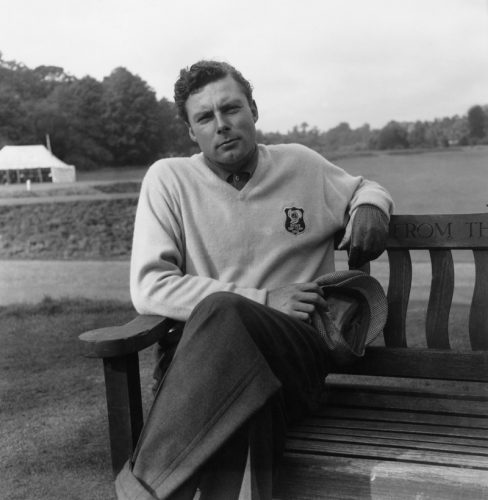
So Hunt and Alliss were seeking redemption at Lindrick, and Rees gave them the opportunity to secure it. Unfortunately, it didn’t quite work out. The Englishmen walked straight into a firestorm. The Americans started with three consecutive threes, went out in 32 and were four up through 15 holes. The young Brits fought back valiantly to limit the deficit to just one at lunch, but Ford and Finsterwald put the pedal to the metal at the start of round two. Hunt and Alliss tried to hold onto their coattails, but that was the best they could do and they eventually lost by 2&1.
Captain Rees backed himself in the second pairing with the experienced Ken Bousfield. It was a bold move by the Welshman given he had won just one half point in four previous Ryder Cup foursomes outings. But his self-confidence proved well founded as he and Bousfield produced a supremely solid performance to defeat Art Wall and Fred Hawkins by 3&2.
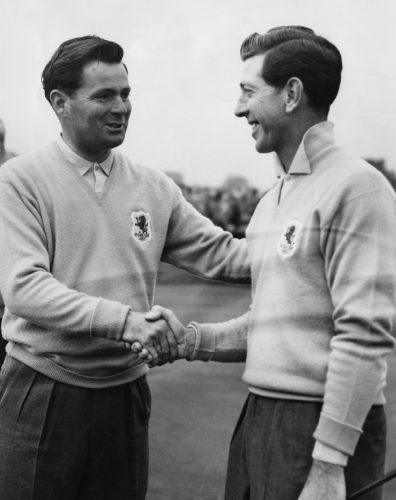
In match three, 1951 Open champion Max Faulkner teamed up with fellow Englishman Harry Weetman who had won only one Ryder Cup match in three previous outings. He wouldn’t add to that total at Lindrick.
Up against U.S. Captain Jack Burke and Ted Kroll, neither of whom had enjoyed particularly successful seasons, the Brits were fancied to win. But, after a scrappy first round the Americans went to lunch one hole ahead.
Both sides had played poorly over the first 18 holes and the general consensus amongst spectators and press was that the Englishmen would find their games in the afternoon and the yanks would crumble. The exact opposite happened, Kroll and Burke raced to the turn in 33 and encountered only minimal resistance. The Americans cruised home 4&3 winners.
In the final foursomes contest, there was very little contest. The potentially fiery Celtic alliance of Ireland’s Christy O’Connor and Scotland’s Eric Brown failed to ignite and they were brushed aside 7&5 by Dick Mayer and the tempestuous Tommy Bolt.
GB&I were down by 3 points to 1 after day one and it all felt rather familiar. If Rees was going to avoid captaining another losing side he needed things shaken up a bit.
Firstly he dropped Max Faulkner and Harry Weetman from the singles. Faulkner took it on the chin and played a pivotal supporting role on the final day, Weetman was incensed and stated he’d, “never play in a team captained by Rees again.”
The weather played its part – the wind picked up on day two and the gustier conditions undoubtedly favoured the home players who were used to battling the breeze on the British and Irish links.
Another change was ostensibly made by the greenkeepers, although it’s hard to imagine Rees had no part in it. The putting surfaces were cut shorter for day two making them significantly quicker. The British and Irish seemed to realise this, but the Americans took some time to adapt. No fewer than six of the U.S. players three-putted the first green.
In the first singles match “Terrible” Tommy Bolt took on hardy Scotsman Eric Brown. In a hostile encounter, Bolt felt the partisan crowd overstepped the mark. “They cheered when I missed a putt and sat on their hands when I hit a good shot,” he said later.
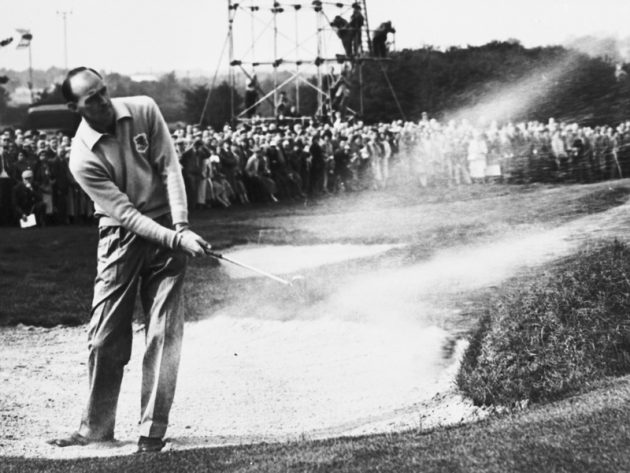
When Brown took the win by 4&3 the pair did not shake hands. Afterwards Bolt told the press he hadn’t enjoyed the match before snapping a wedge in half in the locker room and refusing to attend the presentation.
Jack Burke hadn’t intended to play the singles but when Ted Kroll fell ill, the American captain stepped in at late notice to take on Peter Mills in match two.
It was a one-sided affair with Burke playing some untypically sloppy golf in the first round. The American limped in to lunch five down. Although Burke’s game improved in the afternoon, Mills held on to win the only Ryder Cup match he would ever play by 5&3.
In contrast to the lacklustre performance of the American captain, GB&I’s skipper put on a sparkling display against Ed Furgol. Rees stormed through the first round, birdieing the par-3 last to go into lunch four ahead. Furgol, in his one and only Ryder Cup match, didn’t know what had hit him. The Welshman continued the onslaught in the afternoon and handed his opponent a “dog licence” winning by 7&6. Also legally permitted to keep a dog following the conclusion of his match was Dow Finsterwald. Having played so well against Alliss and Hunt, the American was expected to cruise past Christy O’Connor.
But, thanks to a new putter bought in the pro-shop at lunch, the Irishman caught fire in the afternoon and scorched to a comprehensive victory.
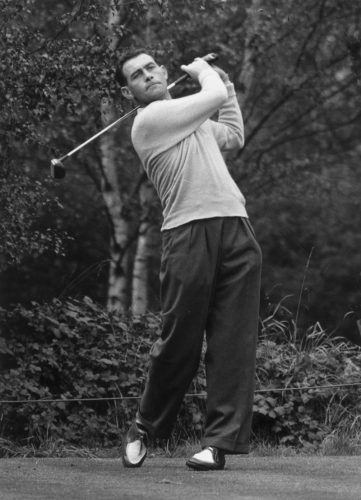
There was also a convincing win for Bernard Hunt. The young Englishman thumped matchplay supremo Doug Ford by 6&5 to well and truly heal the injuries of 1953. Unfortunately, Peter Alliss couldn’t find the same elixir in his match with Fred Hawkins, as he went down by 2&1.
With only one singles point on the board for the Americans, Ken Bousfield had the chance to claim the winning point for GB&I against USPGA champion Lionel Hebert. The result of this one was never in doubt with Bousfield five up by lunch. Although Hebert refused to lie down, he couldn’t rally sufficiently to deny Bousfield a 4&3 win. The Englishman tapped in a two-foot putt at the 33rd hole to secure the Ryder Cup for Great Britain and Ireland.
After Harry Bradshaw and Dick Mayer had played out an exciting half, GB&I had won the singles by 6.5 to 1.5 and the match overall by 7.5 to 4.5.
It was the worst ever singles performance by the Americans in the Ryder Cup and, as Ed Furgol said afterwards, they were, “well and truly licked.”
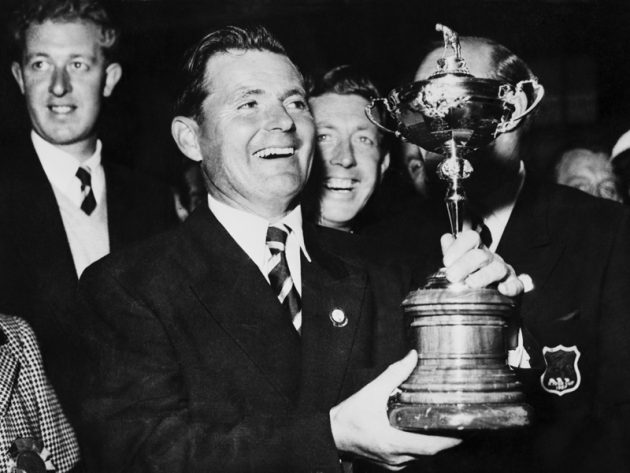
Although an elated Dai Rees described the victory as a, “shot in the arm for British and Irish golf,” the syringe contained only a placebo. GB&I were beaten soundly in nine of the next 10 Ryder Cups with only an unofficial half in 1969 to partially celebrate – the USA retained the trophy in that event.
GB&I became Europe in 1979 thanks to Jack Nicklaus’ necessary intervention, but even then, they lost three more Cups before Tony Jacklin’s men finally triumphed in 1985 and ushered in a new era of closely fought matches. Sadly Dai Rees wasn’t around to witness the USA’s first defeat since Lindrick, the Welshman died after a car crash in 1983.
Scores from 1957
36-hole foursomes:
Peter Alliss & Bernard Hunt lost to Ford & Dow Finsterwald by 2&1
Ken Bousfield & Dai Rees beat Art Wall & Fred Hawkins by 3&2
Max Faulkner & Harry Weetman lost to Ted Kroll & Jack Burke by 4&3
Christy O’Connor & Eric Brown lost to Dick Mayer & Tommy Bolt by 7&5
GB&I 1 – USA 3
36-hole singles:
Eric Brown beat Tommy Bolt by 4&3
Peter Mills beat Jack Burke by 5&3
Peter Alliss lost to Fred Hawkins by 2&1
Ken Bousfield beat Lionel Hebert by 4&3
Dai Rees beat Ed Furgol by 7&6
Bernard Hunt beat Doug Ford by 6&5
Christy O’Connor beat Dow Finsterwald by 7&6
Harry Bradshaw halved with Dick Mayer
GB&I 6.5 – USA 1.5
Match: GB&I 7.5 – USA 4.5

Fergus is Golf Monthly's resident expert on the history of the game and has written extensively on that subject. He has also worked with Golf Monthly to produce a podcast series. Called 18 Majors: The Golf History Show it offers new and in-depth perspectives on some of the most important moments in golf's long history. You can find all the details about it here.
He is a golf obsessive and 1-handicapper. Growing up in the North East of Scotland, golf runs through his veins and his passion for the sport was bolstered during his time at St Andrews university studying history. He went on to earn a post graduate diploma from the London School of Journalism. Fergus has worked for Golf Monthly since 2004 and has written two books on the game; "Great Golf Debates" together with Jezz Ellwood of Golf Monthly and the history section of "The Ultimate Golf Book" together with Neil Tappin , also of Golf Monthly.
Fergus once shanked a ball from just over Granny Clark's Wynd on the 18th of the Old Course that struck the St Andrews Golf Club and rebounded into the Valley of Sin, from where he saved par. Who says there's no golfing god?
-
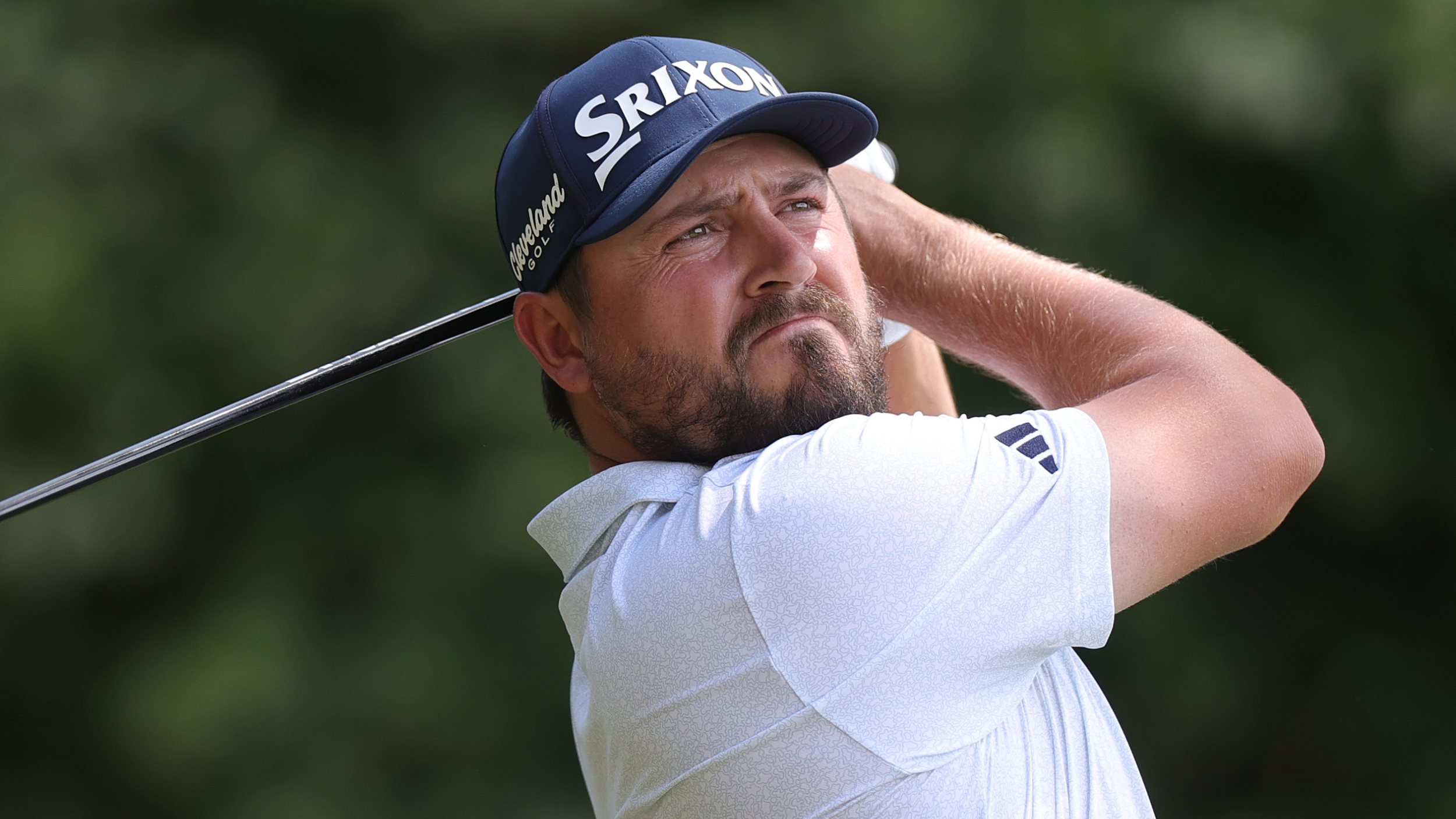 Who Is Andrew Novak's Wife?
Who Is Andrew Novak's Wife?Andrew Novak has been married to wife Maddie since 2020 - here's what we know about her
By Mike Hall
-
 RBC Heritage Leaderboard: Justin Thomas And Andrew Novak Share Lead With Few Holes Remaining
RBC Heritage Leaderboard: Justin Thomas And Andrew Novak Share Lead With Few Holes RemainingJustin Thomas And Andrew Novak share the lead at 17-under with just a few holes remaining, with the American pair searching for a first win of 2025
By Matt Cradock